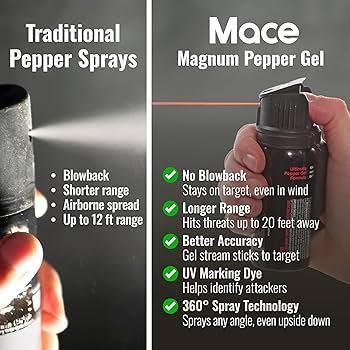Table of Contents
- Understanding the Influence of Wind Direction on Pepper Spray Dispersion
- Analyzing the Impact of Wind Speed on Spray Range and Potency
- Strategies for Effective Pepper Spray Use in Various Wind Conditions
- Safety Precautions and Best Practices When Deploying Pepper Spray Outdoors
- Concluding Remarks
Understanding the Influence of Wind Direction on Pepper Spray Dispersion
When deploying pepper spray in an outdoor environment, the direction of the wind plays a critical role in determining its reach and effectiveness. Spraying against the wind can cause the irritant to blow back toward the user, potentially causing self-contamination and reducing the spray’s defensive capabilities. Conversely, spraying with the wind at your back allows the mist to travel further toward the target, but an exceptionally strong wind might disperse the spray too quickly, diminishing its concentration and impact. Understanding these dynamics is essential for ensuring optimal deployment and personal safety during high-stress situations.
Key considerations to keep in mind:
- Identify wind direction before spraying to avoid unintended exposure.
- Adjust your stance by positioning yourself with the wind at your side or slightly downwind.
- Account for variable wind speeds as gusts can unpredictably alter the spray’s trajectory.
- Practice situational awareness to anticipate environmental conditions that may affect dispersal.
Mastering the interaction between wind and spray dispersion not only increases the likelihood of incapacitating an aggressor effectively but also ensures your own safety by minimizing risks of self-exposure. Regular training in diverse outdoor conditions will build confidence in handling these environmental variables with precision and care.
Analyzing the Impact of Wind Speed on Spray Range and Potency
Wind speed plays a crucial role in determining how far and how effectively pepper spray can reach its target. When sprayed against a strong wind, the range drastically decreases as the particles are pushed back toward the user, increasing the risk of self-contamination. Conversely, spraying with the wind enhances the range but can lead to dispersion of the spray, reducing its concentration and overall potency. Understanding the dynamics of wind allows users to adjust their positioning and spraying technique for maximum impact.
Several factors illustrate the complexity of wind’s effect on pepper spray performance:
- Spray Drift: High winds cause the mist to drift unpredictably, making it harder to accurately target an assailant.
- Concentration Dilution: As spray particles spread over a wider area, the active capsaicin compounds become diluted, weakening the incapacitating effect.
- Spray Distance Variability: Moderate winds may aid spray range, while gusty conditions create inconsistent dispersal patterns.
Strategies for Effective Pepper Spray Use in Various Wind Conditions
Mastering pepper spray efficacy requires adapting your deployment technique to the wind’s behavior. On calm days, a straightforward, controlled burst aimed at the attacker’s face usually suffices. However, when the breeze is light but consistent, position yourself so that the wind directs the spray towards your target. Standing with your back to the wind may inadvertently blow the formula back into your face, reducing effectiveness and risking self-exposure. In unpredictable gusts, short, deliberate bursts rather than a single long spray help maintain control, minimizing wastage and maximizing impact.
Strong winds demand even more caution and strategy. If facing headwinds, consider the option of repositioning to a sheltered spot before discharging your spray, as the mist can scatter unpredictably and diminish its reach. When the wind is at your side, angle your canister to allow the spray to travel with the airflow, ensuring optimal contact with the assailant’s face. Remember, the goal is not only to incapacitate but also to protect yourself. Key tactics include:
- Assess wind speed and direction before use;
- Keep a safe distance while adjusting your stance;
- Employ multiple short bursts to conserve spray and adapt to wind shifts;
- Practice drills in varied conditions to build confidence and accuracy.
Safety Precautions and Best Practices When Deploying Pepper Spray Outdoors
When deploying pepper spray in outdoor environments, it’s crucial to be aware of wind direction and strength to avoid self-contamination or ineffective use. Always position yourself upwind of your target to ensure that the spray travels away from you, reducing the risk of blowback. If the wind is strong or unpredictable, consider waiting for a safer moment or adjusting your angle-deploying pepper spray against the wind can result in the aerosol drifting back into your face, causing irritation and impairing your ability to respond effectively.
Beyond wind considerations, adopting best practices improves both safety and performance. Make sure to test your spray regularly (in a secure environment) to familiarize yourself with its range and spray pattern-this can help you gauge how weather conditions might alter effectiveness. Carry your spray in an accessible yet secure holster, and practice controlled, short bursts rather than prolonged sprays to conserve contents and maintain accuracy. Remember to wear protective eyewear if available, especially in windy conditions, and always be mindful of bystanders and environmental factors like enclosed spaces or flammable materials.
- Check the wind direction before deployment and position yourself accordingly.
- Practice controlled bursts to maximize spray efficiency.
- Keep a safe distance-between 6 to 10 feet for optimal impact.
- Store pepper spray securely but within reach in case of emergency.
- Regularly inspect expiration dates and replace when necessary.
Concluding Remarks
In conclusion, understanding how wind influences pepper spray performance is crucial for its effective use in self-defense situations. While pepper spray remains a powerful deterrent, environmental factors like wind direction and strength can significantly impact its dispersal and potency. By being mindful of these conditions and adjusting your technique accordingly, you can maximize the spray’s effectiveness and ensure greater personal safety. Stay informed, stay prepared, and always prioritize your awareness of the environment when relying on pepper spray as a protective tool.Check Our Other Blogs
- StunGun – Your Trusted Source for Stun Guns, Laws, and Self-Defense Tips
- PepperSprayLaws – Your Trusted Resource for Pepper Spray Information
- StunGunLaws – Your Trusted Guide to Stun Gun Legality and Safety




